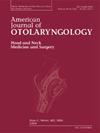Telehealth utilization and perceptions among deaf or hard of hearing adults: A cross-sectional analysis of the HINTS6 national dataset
IF 1.7
4区 医学
Q2 OTORHINOLARYNGOLOGY
引用次数: 0
Abstract
Objective
Telehealth has emerged as a vital medium for healthcare delivery and has been integrated increasingly in clinic and hospital settings in the post-COVID-19 era. However, accessibility of telehealth for individuals who are deaf or hard of hearing (DHH) remains underexplored. As effective communication is critical to high-quality healthcare, a deeper understanding of how DHH individuals interact with telehealth and identifying specific barriers they face can inform targeted interventions to improve care.
Methods
We conducted a cross-sectional analysis of the 2022 Health Information National Trends Survey (HINTS 6), a nationally representative dataset. Respondents were stratified by self-identified DHH status. Demographic, internet access, health behavior, and telehealth perception variables were compared between DHH and normal hearing individuals. Statistical analyses were performed using chi-square tests and t-tests.
Results
Among 5694 respondents, 521 identified as DHH. Chi-square testing found that DHH patients reported poorer general health (p < 0.01), lower internet use (p < 0.01), and less engagement with online health resources (p < 0.01), with similar rates of telehealth being offered and utilized. However, DHH individuals were less likely to perceive telehealth as convenient (p = 0.04) and more likely to cite difficulty using the platform (p = 0.01). They were also more likely to value the inclusion of others in their telehealth visits (p < 0.01) and report technical issues (p < 0.01).
Conclusions
While DHH individuals use telehealth at similar rates to the general population, they face significant barriers related to convenience, usability, and communication. Enhancing platform accessibility and expanding support for these patients can help reduce difficulties and further promote equity in telehealth.
聋人或重听成年人的远程医疗利用和感知:对HINTS6国家数据集的横断面分析
目的在后covid -19时代,远程医疗已成为医疗保健服务的重要媒介,并越来越多地融入诊所和医院环境。然而,聋人或重听人(DHH)获得远程医疗的可能性仍未得到充分探索。由于有效的沟通对高质量的医疗保健至关重要,因此更深入地了解DHH个人如何与远程医疗互动,并确定他们面临的具体障碍,可以为有针对性的干预措施提供信息,以改善护理。方法对2022年健康信息全国趋势调查(HINTS 6)这一具有全国代表性的数据集进行了横断面分析。受访者按自我认定的DHH状况分层。比较DHH和正常听力个体的人口统计学、互联网访问、健康行为和远程医疗感知变量。采用卡方检验和t检验进行统计学分析。结果5694名被调查者中,521人被确定为DHH。卡方检验发现DHH患者总体健康状况较差(p <;0.01),互联网使用率较低(p <;0.01),较少使用在线健康资源(p <;0.01),提供和利用远程保健的比率相似。然而,DHH个体不太可能认为远程医疗方便(p = 0.04),更有可能引用使用平台的困难(p = 0.01)。他们也更有可能重视将他人纳入远程医疗访问(p <;0.01)并报告技术问题(p <;0.01)。虽然DHH患者使用远程医疗的比例与一般人群相似,但他们在便利性、可用性和沟通方面面临着重大障碍。加强平台的可及性和扩大对这些患者的支持有助于减少困难并进一步促进远程保健的公平性。
本文章由计算机程序翻译,如有差异,请以英文原文为准。
求助全文
约1分钟内获得全文
求助全文
来源期刊

American Journal of Otolaryngology
医学-耳鼻喉科学
CiteScore
4.40
自引率
4.00%
发文量
378
审稿时长
41 days
期刊介绍:
Be fully informed about developments in otology, neurotology, audiology, rhinology, allergy, laryngology, speech science, bronchoesophagology, facial plastic surgery, and head and neck surgery. Featured sections include original contributions, grand rounds, current reviews, case reports and socioeconomics.
 求助内容:
求助内容: 应助结果提醒方式:
应助结果提醒方式:


